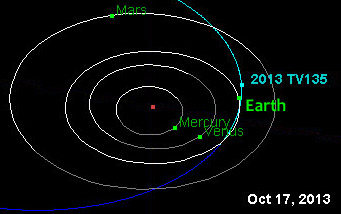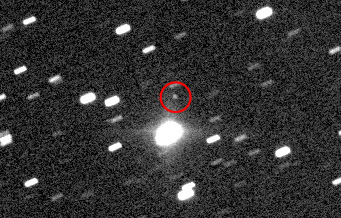On October 8th, Russian astronomers spotted a largish near-Earth asteroid discovered that had passed Earth's vicinity three weeks earlier. For the moment, there's a 1-in-14,000 chance that it will hit us in 2032.
| Update, November 4th:According to new calculations by NASA's Near-Earth Object office, the likelihood that this asteroid will collide with Earth in 2032 has dropped to about one in 21 million. |

Based on early observations, the near-Earth asteroid circles the Sun every 2.46 years in a low-inclination, high-eccentricity orbit. It came close to Earth in mid-September 2013 and might come much closer in August 2032.
NASA / JPL / NEO Science Office
But I'm not marking my long-term calendar for this one. Right now the odds of a collision are about 1 in 14,000 according to NASA (an update from the initial 1-in-63,000 odds) and 1 in 7,500 according to the University of Pisa's NEODys team.
Those orbital calculations are very rough, computed from only a few dozen observations made during the past 10 days. "TV135 will remain observable through next March," notes veteran solar-system observer David Tholen (University of Hawaii). "Most likely, this one will drop from the risk list long before then."
Nonetheless, there's plenty of hoopla over this incidental interloper, fueled initially by Russian news reports and later by sensational headlines in British tabloids.

A short exposure with a 17-inch robotic telescope captured the asteroid 2013 TV135 (inside red circle) at 20:53 Universal Time on October 17, 2013. At the time the interloper was magnitude 17.8 and moving away from Earth. A short exposure with a 17-inch robotic telescope captured the asteroid 2013 TV135 (inside red circle) at 20:53 Universal Time on October 17, 2013. The relatively bright star just below it is a close pairing of BD+65486B and HD 37337.
Gianluca Masi / Virtual Telescope Project
In fact, all that unfounded worry is the only reason I'm writing this. NASA's celestial dynamicists even felt the need to issue a "reality check" yesterday about 2013 TV135. "The current probability of no impact in 2032 at about 99.998%," says Don Yeomans, who manages NASA's Near-Earth Object Program Office at the Jet Propulsion Laboratory in California.
Don't blame Borisov and Kryachko for this. Both are well-regarded observers — Borisov for his discovery of comet C/2013 N4 earlier this year and Kryachko for his variable-star work.
Give the bright Moon a few days to get out of the way so more observations can be taken, and I predict 2013 TV135 will become the latest in a decades-long list of asteroids that got everyone needlessly rattled.
 10
10
Comments
adolfo rufatt
October 18, 2013 at 2:48 pm
The concern is not about 2032 but that we saw it almost a month AFTER it went by...
You must be logged in to post a comment.
Tom Wier
October 18, 2013 at 3:42 pm
A little excitement in the public will help keep funding going in a time of desperate finances.
You must be logged in to post a comment.
Anthony Barreiro
October 18, 2013 at 4:10 pm
Tom, if you're making a joke please forgive me for taking you seriously. Irresponsible misinformation and unfounded fears are not good bases for reliable public funding for science and technology. Emotionally fueled memories are short and fickle, and after multiple false alarms people simply discount everything, including realistic warnings (consider public attitudes toward global warming and climate change). It's much better to give people accurate information and help them to assess probabilities, risks, and priorities intelligently. An educated and engaged public is more likely to support scientific research and appropriate technologies over the long term.
You must be logged in to post a comment.
Grant Martin
October 18, 2013 at 5:12 pm
One chance in 63,000 or 1 in 23,000 may be long odds, but even 1 in a million is too big a chance when we could be hit by a 1,300 foot (1/4 mile) diameter asteroid. If that thing were to land in the Atlantic, the resulting waves would be catastrophic for ALL coastal areas and cities.
We need to fund a preventive strategy. We have the means of detection, and the technology to get something launched to intercept. A few billion dollars spent over the next few years would be very cheap insurance, considering the consequences.
You must be logged in to post a comment.
Tom Fleming
October 19, 2013 at 1:49 am
I feel a "Tsk,Tsk" coming on. All of this chatter about the emotional impact of the impact and not a single reference to the Torino Impact Scale, the chart designed to eliminate the waste of energy associated with angst. Though the scale may have been referred to in other of which I am unaware, I'm wondering why it isn't being employed in this article.
You must be logged in to post a comment.
tom hoffelder
October 19, 2013 at 7:51 am
"Noise and Signal. The odds of using, 10 years from now, something picked up today from random media is < 1 in 50,000. In science (outside of mathematics) it is < 1 in 30,000. On the other hand, you have more than 50% chance of using (or remembering) something that you are interested in and has been 'in print' more than a century." ~ Nassim Nicholas Taleb
You must be logged in to post a comment.
Paul Vondra
October 19, 2013 at 10:23 am
If that 1 in 63,000 chance panned out and the Earth took a direct hit from this thing, the casualty list would be hard-put to equal that of all of humanity's wars and conflicts between now and then. Instead of fretting about monumentally unlikely future possibilities, why can't we try to do something about the certain ones that are actually within our power to prevent?
You must be logged in to post a comment.
Kelly Beatty
October 20, 2013 at 12:40 pm
Tom... I considered including mention of the Torino scale, but the reality is that this object is likely to drop off the scale completely any day now. tell you what: if it doesn't, I'll add a graf about that!
You must be logged in to post a comment.
Wayne Smith
October 20, 2013 at 10:54 pm
Adolfo - I'm not so concerned that it wasn't noticed since when it "went by" it was 4.2 million miles away.
You must be logged in to post a comment.
Andrew
October 21, 2013 at 1:25 pm
Look here http://deepspace-explorer.blogspot.it/
They say that we have 96% of possibilities to be hit by an invisible asteroid. Shall we really worry about it?
You must be logged in to post a comment.
You must be logged in to post a comment.